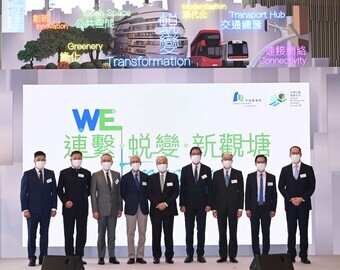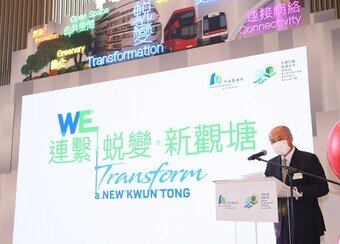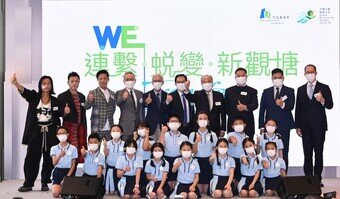


URA’s Kwun Tong Town Centre Project Pioneer in “District-based” Planning Approach to Rejuvenate Old District
The Urban Renewal Authority (URA) celebrated today (29 June 2021) the completion of the residential project Grand Central and the opening of the shopping mall Yue Man Square (YM2) at the Development Areas 2 & 3 of the Kwun Tong Town Centre Redevelopment Project (K7 Project).
The URA has been carrying out the urban renewal for 20 years since it was established by the Government in May 2001 under a new statutory framework and vision. The achievements made in the K7 Project is a testament that the URA has fully embraced the “people first, district-based and public participatory” approach in its urban renewal work. It worked closely with community members to formulate plans to improve the overall living conditions of residents and the community facilities in the old district, benefitting the entire Kwun Tong.
The K7 Project is the URA’s largest single redevelopment project ever. For this, the URA set up the Kwun Tong District Advisory Committee before the commencement of the project to gauge views from the public and stakeholders through extensive public engagement exercises from 2005 to 2007. Their needs and aspirations for the future development of the Kwun Tong Town Centre were considered throughout the planning and design processes, which helped secure the unwavering support from the Kwun Tong community.
The K7 Project covers a total site area of 53,500 square metres, with a phased redevelopment of five areas. Under the “district-based” planning approach, the traffic network in Development Areas 2 & 3 has been restructured to resolve traffic congestion problems, as well as improved the pedestrian environment with wider pavements and more barrier-free access facilities. In addition, the URA has allocated over 170,000 square feet of the floor space from the Project’s commercial portion, for public facilities. These facilities include Hong Kong’s first air-conditioned waiting area of the bus terminus in a covered public transport interchange, the Hong Kong’s first air-conditioned hawker bazaar, a 24-hour public passageway, and 7,100 square metres of green open space.
The URA has strived to preserve the local characteristics by setting up Yue Man Lane and the Yue Man Hawker Bazaar in YM2, where vendors from street shops and hawker markets in the area before the redevelopment can continue their businesses in the same locality, thus retaining the street market traditions and the neighbourhood ties.
The URA held the grand opening ceremony of YM2 cum the URA’s 20th anniversary celebration today at the community space at the mall’s atrium to commemorate this remarkable milestone with members of the public and stakeholders, and to mark a new chapter of the K7 Project.
The ceremony was officiated by Secretary for Development, Mr Michael Wong, Secretary for Transport and Housing, Mr Frank Chan Fan, Chairman of the URA, Mr Chow Chung-kong, past Chairmen of the URA, Mr Victor So Hing-woh and Mr Edward Cheng Wai-sun, Managing Director of the URA, Ir Wai Chi-sing, Chairman of the Kwun Tong District Council, Mr Choy Chak-hung, past Chairman of the Kwun Tong District Council, Mr Bunny Chan Chung-bun, and Deputy Chairman of Sino Group, Mr Daryl Ng Win-kong.
Speaking at the ceremony, URA Chairman, Mr Chow, said, “The URA took a forward-looking planning and development approach some 14 years ago for the K7 Project, with the objectives to improve the living environment of the residents, and to make Kwun Tong a role model as the city centre of the 21st century, one which accommodates the demands of the district’s rapidly-growing population.
The completion of Grand Central and the opening of YM2 is one of the achievements in urban renewal by the URA, in which through restructuring land uses within and around the project site, instead of having the conventional building-by-building redevelopment process, the Project has enhanced the urban design, created a more efficient transport and pedestrian network, improved public facilities and liveability, for the good of the entire Kwun Tong community.”
Mr Michael Wong remarked, “The Government launched the initiative of ‘Energising Kowloon East’ in 2011, with an aim to transforming Kwun Tong, Kowloon Bay and Kai Tak into Hong Kong’s second Central Business District (CBD). The K7 Project complements the transformation of Kowloon East by optimising the use of land and space, regenerating the town centre with modern facilities and increasing housing supply, greenery and public open space. The Project makes Kwun Tong a role model in urban renewal. The government will continue to support the URA in driving sustainable urban renewal to create a people-orientated community.”
Mr Frank Chan Fan remarked, “Kwun Tong is the heart and focal point of Kowloon East, where people, logistics, and commerce meet. The redevelopment provided the opportunity to enhance the community environment, and bring further convenience and new experiences for the public. The Yue Man Square Public Transport Interchange (PTI) is the largest covered PTI in Hong Kong. It brings many of the street side stops of bus and minibus routes together to one place serving the entire territory, improving greatly the connectivity of the transportation network. This PTI boasts of many smart and user-friendly features, including the Hong Kong’s first air-conditioned waiting area of the bus terminus with the segregation of passengers from vehicular traffic, which improves the passenger experience as they wait for their services. ”
To celebrate the completion of K7’s Development Areas 2 & 3, the URA is organising a “Kwun Tong in Transformation” photo exhibition from today to 11 July, at the atrium on the first floor of YM2. The exhibition will feature some 40 pieces of work provided by Hong Kong history lovers, District Councillors, local leaders, residents, local artists, and photographers. The treasure trove of photographs of the old and new Kwun Tong will showcase the enhanced living standard and public facilities brought about by the redevelopment of the Kwun Tong Town Centre over the years.
(ENDS)
